Socio-Economic Factors Related to Drinking Water Source and Sanitation in Malaysia
Abstract
1. Introduction
2. Materials and Methods
2.1. Data Source
2.2. Data Analysis
3. Results
4. Discussion
5. Conclusions
Author Contributions
Funding
Acknowledgments
Conflicts of Interest
Appendix A
| Type of Houses | Type of Water Source a,b | |||||||||||||||||
|---|---|---|---|---|---|---|---|---|---|---|---|---|---|---|---|---|---|---|
| Piped Water that Runs into House | Piped Water in Yard | Public Standpipe | Bottled Drinking Water (Mineral/Distilled) | Protected Dug Well or Protected Spring | Unprotected Dug Well or Spring | Rainwater (into Tank or Cistern) | Water Taken Directly from Pond or Stream | Tanker-Truck, Vendor | ||||||||||
| Count | % | Count | % | Count | % | Count | % | Count | % | Count | % | Count | % | Count | % | Count | % | |
| Overall | 7102 | 89.0 | 188 | 2.4 | 90 | 1.1 | 110 | 1.4 | 183 | 2.3 | 24 | 0.3 | 61 | 0.8 | 51 | 0.6 | 7 | 0.1 |
| Education level | ||||||||||||||||||
| No formal | 455 | 77.8 | 16 | 2.7 | 16 | 2.7 | 6 | 1.0 | 29 | 5.0 | 6 | 1.0 | 25 | 4.3 | 16 | 2.7 | 0 | 0.0 |
| Primary | 2050 | 88.1 | 71 | 3.1 | 30 | 1.3 | 18 | 0.8 | 50 | 2.1 | 10 | 0.4 | 25 | 1.1 | 18 | 0.8 | 6 | 0.3 |
| Secondary | 3027 | 89.8 | 81 | 2.4 | 40 | 1.2 | 44 | 1.3 | 85 | 2.5 | 4 | 0.1 | 9 | 0.3 | 16 | 0.5 | 1 | 0.03 |
| Tertiary | 1501 | 92.8 | 18 | 1.1 | 4 | 0.2 | 41 | 2.5 | 19 | 1.2 | 4 | 0.2 | 2 | 0.1 | 0 | 0.0 | 0 | 0.0 |
| Unclassified | 58 | 90.6 | 2 | 3.1 | 0 | 0 | 1 | 1.6 | 0 | 0.0 | 0 | 0.0 | 0 | 0.0 | 0 | 0.0 | 0 | 0.0 |
| HH Income Quintiles | ||||||||||||||||||
| Q1 | 1314 | 86.1 | 45 | 2.9 | 23 | 1.5 | 13 | 0.9 | 42 | 2.8 | 9 | 0.6 | 16 | 1.0 | 25 | 1.6 | 1 | 0.1 |
| Q2 | 1445 | 85.3 | 57 | 3.4 | 27 | 1.6 | 15 | 0.9 | 67 | 4.0 | 4 | 0.2 | 25 | 1.5 | 11 | 0.6 | 4 | 0.2 |
| Q3 | 1545 | 90.4 | 37 | 2.2 | 18 | 1.1 | 20 | 1.2 | 32 | 1.9 | 6 | 0.4 | 12 | 0.7 | 9 | 0.5 | 2 | 0.1 |
| Q4 | 1329 | 90.8 | 26 | 1.8 | 16 | 1.1 | 27 | 1.8 | 25 | 1.7 | 4 | 0.3 | 5 | 0.3 | 5 | 0.3 | 0 | 0 |
| Q5 | 1469 | 92.8 | 23 | 1.5 | 6 | 0.4 | 35 | 2.2 | 17 | 1.1 | 1 | 0.1 | 3 | 0.2 | 1 | 0.1 | 0 | 0 |
| Geographical location | ||||||||||||||||||
| Urban | 4304 | 92.5 | 72 | 1.5 | 25 | 0.5 | 87 | 1.9 | 82 | 1.9 | 10 | 0.2 | 1 | 0.02 | 3 | 0.1 | 2 | 0.04 |
| Rural | 2798 | 84.2 | 116 | 3.5 | 65 | 2.0 | 23 | 0.7 | 101 | 3.0 | 14 | 0.4 | 60 | 1.8 | 48 | 1.4 | 5 | 0.2 |
| House Type | ||||||||||||||||||
| Single House | 2132 | 89.5 | 96 | 4.0 | 6 | 0.3 | 13 | 0.5 | 104 | 4.4 | 11 | 0.5 | 5 | 0.2 | 14 | 0.6 | 1 | 0.0 |
| Semi-D | 292 | 90.7 | 4 | 1.2 | 0 | 0.0 | 6 | 1.9 | 8 | 2.5 | 0 | 0.0 | 9 | 2.8 | 2 | 0.6 | 1 | 0.3 |
| Condominium/Apartment | 404 | 92.0 | 3 | 0.7 | 1 | 0.2 | 30 | 6.8 | 1 | 0.2 | 0 | 0.0 | 0 | 0.0 | 0 | 0.0 | 0 | 0.0 |
| Terrace Single Storey | 1491 | 98.6 | 14 | 0.9 | 1 | 0.1 | 6 | 0.4 | 0 | 0.0 | 0 | 0.0 | 0 | 0.0 | 0 | 0.0 | 0 | 0.0 |
| Terrace Double Storey | 884 | 96.5 | 9 | 1.0 | 1 | 0.1 | 22 | 2.4 | 0 | 0.0 | 0 | 0.0 | 0 | 0.0 | 0 | 0.0 | 0 | 0.0 |
| Long House | 31 | 57.4 | 2 | 3.7 | 0 | 0.0 | 0 | 0.0 | 0 | 0.0 | 0 | 0.0 | 15 | 27.8 | 6 | 11.1 | 0 | 0.0 |
| Flat | 495 | 96.7 | 3 | 0.6 | 3 | 0.6 | 11 | 2.1 | 0 | 0.0 | 0 | 0.0 | 0 | 0.0 | 0 | 0.0 | 0 | 0.0 |
| Squatters | 49 | 87.5 | 2 | 3.6 | 0 | 0.0 | 0 | 0.0 | 0 | 0.0 | 0 | 0.0 | 0 | 0.0 | 4 | 7.1 | 1 | 1.8 |
| Village House | 1134 | 81.8 | 36 | 2.6 | 75 | 5.4 | 17 | 1.2 | 68 | 4.9 | 12 | 0.9 | 19 | 1.4 | 25 | 1.8 | 1 | 0.1 |
| Shop House | 105 | 92.1 | 4 | 3.5 | 0 | 0.0 | 4 | 3.5 | 1 | 0.9 | 0 | 0.0 | 0 | 0.0 | 0 | 0.0 | 0 | 0.0 |
| Shared House | 84 | 69.4 | 15 | 12.4 | 3 | 2.5 | 1 | 0.8 | 1 | 0.8 | 1 | 0.8 | 13 | 10.7 | 0 | 0.0 | 3 | 2.5 |
Appendix B
| Variables | What Is the Type of Toilet at Your House? a,b | |||||||||||||||
|---|---|---|---|---|---|---|---|---|---|---|---|---|---|---|---|---|
| Flush Toilet and Connected to the Main Sewerage System | Flush Toilet with Septic Tank | Pour Flush Toilet | Bore Hole Toilet with Closed Lid | Bore Hole Toilet without Cover | Bucket Latrine | Hanging Latrine | No Facilities at All | |||||||||
| Count | % | Count | % | Count | % | Count | % | Count | % | Count | % | Count | % | Count | % | |
| Overall | 3800 | 48.0 | 2116 | 26.7 | 1837 | 23.2 | 127 | 1.6 | 7 | 0.1 | 3 | 0.04 | 16 | 0.2 | 18 | 0.2 |
| Education | ||||||||||||||||
| No formal education | 154 | 26.3 | 130 | 22.2 | 271 | 46.3 | 11 | 1.9 | 3 | 0.5 | 0 | 0.0 | 6 | 1.0 | 5 | 0.9 |
| Primary | 833 | 35.8 | 628 | 27.0 | 778 | 33.4 | 62 | 2.7 | 1 | 0.04 | 1 | 0.04 | 8 | 0.3 | 6 | 0.3 |
| Secondary | 1664 | 49.4 | 967 | 28.7 | 665 | 19.7 | 44 | 1.3 | 2 | 0.1 | 1 | 0.03 | 1 | 0.03 | 7 | 0.2 |
| Tertiary | 1113 | 68.8 | 374 | 23.1 | 103 | 6.4 | 10 | 0.6 | 0 | 0.0 | 1 | 0.1 | 1 | 0.1 | 0 | 0.0 |
| Unclassified | 31 | 48.4 | 17 | 26.6 | 15 | 23.4 | 0 | 0.0 | 0 | 0.0 | 0 | 0.0 | 0 | 0.0 | 0 | 0.0 |
| Missing | 5 | 33.3 | 0 | 0.0 | 5 | 33.3 | 0 | 0.0 | 1 | 6.7 | 0 | 0.0 | 0 | 0.0 | 0 | 0.0 |
| Household income quintile | ||||||||||||||||
| Q1 | 516 | 33.8 | 381 | 25.0 | 560 | 36.7 | 35 | 2.3 | 1 | 0.1 | 1 | 0.1 | 9 | 0.6 | 8 | 0.5 |
| Q2 | 615 | 36.3 | 467 | 27.6 | 560 | 33.1 | 34 | 2.0 | 3 | 0.2 | 0 | 0.0 | 3 | 0.2 | 5 | 0.3 |
| Q3 | 791 | 46.3 | 492 | 28.8 | 378 | 22.1 | 26 | 1.5 | 1 | 0.1 | 1 | 0.1 | 4 | 0.2 | 4 | 0.2 |
| Q4 | 822 | 56.1 | 388 | 26.5 | 226 | 15.4 | 17 | 1.2 | 2 | 0.1 | 0 | 0.0 | 0 | 0.0 | 1 | 0.1 |
| Q5 | 1056 | 66.7 | 388 | 24.5 | 113 | 7.1 | 15 | 0.9 | 0 | 0.0 | 1 | 0.1 | 0 | 0.0 | 0 | 0.0 |
| Strata | ||||||||||||||||
| Urban | 2923 | 62.8 | 1117 | 24.0 | 544 | 11.7 | 21 | 0.5 | 3 | 0.1 | 2 | 0.0 | 7 | 0.2 | 3 | 0.1 |
| Rural | 877 | 26.4 | 999 | 30.1 | 1293 | 38.9 | 106 | 3.2 | 4 | 0.1 | 1 | 0.0 | 9 | 0.3 | 15 | 0.5 |
| House types | ||||||||||||||||
| Single house | 743 | 30.6 | 850 | 35.1 | 747 | 30.8 | 70 | 2.9 | 1 | 0.04 | 1 | 0.04 | 4 | 0.2 | 7 | 0.3 |
| Semi-D | 157 | 48.0 | 102 | 31.2 | 66 | 20.2 | 2 | 0.6 | 0 | 0.0 | 0 | 0.0 | 0 | 0.0 | 0 | 0.0 |
| Condominium/Apartment | 381 | 86.8 | 52 | 11.8 | 3 | 0.7 | 2 | 0.5 | 0 | 0.0 | 0 | 0.0 | 1 | 0.2 | 0 | 0.0 |
| Terrace single storey | 1047 | 68.6 | 391 | 25.6 | 80 | 5.2 | 4 | 0.3 | 1 | 0.1 | 0 | 0.0 | 0 | 0.0 | 0 | 0.0 |
| Terrace double storey | 739 | 79.5 | 164 | 17.7 | 23 | 2.5 | 2 | 0.2 | 0 | 0.0 | 0 | 0.0 | 0 | 0.0 | 0 | 0.0 |
| Long house | 8 | 14.0 | 21 | 36.8 | 27 | 47.4 | 1 | 1.8 | 0 | 0.0 | 0 | 0.0 | 0 | 0.0 | 0 | 0.0 |
| Flat | 387 | 75.3 | 114 | 22.2 | 13 | 2.5 | 0 | 0.0 | 0 | 0.0 | 0 | 0.0 | 0 | 0.0 | 0 | 0.0 |
| Squatters | 18 | 30.5 | 15 | 25.4 | 19 | 32.2 | 0 | 0.0 | 1 | 1.7 | 0 | 0.0 | 6 | 10.2 | 0 | 0.0 |
| Village house | 226 | 16.0 | 367 | 26.0 | 759 | 53.8 | 42 | 3.0 | 2 | 0.1 | 1 | 0.1 | 4 | 0.3 | 9 | 0.0 |
| Shop house | 64 | 53.8 | 28 | 23.5 | 25 | 21.0 | 1 | 0.8 | 0 | 0.0 | 0 | 0.0 | 0 | 0.0 | 0 | 0.0 |
| Shared house | 29 | 23.2 | 12 | 9.6 | 75 | 60.0 | 3 | 2.4 | 2 | 1.6 | 1 | 0.8 | 1 | 0.8 | 2 | 1.6 |
| Missing | 1 | 2.2 | 0 | 0.0 | 0 | 0.0 | 0 | 0.0 | 0 | 0.0 | 0 | 0.0 | 0 | 0.0 | 45 | 97.8 |
Appendix C
| Variable | Method of Domestic Waste Disposal a, b | |||||||||||
|---|---|---|---|---|---|---|---|---|---|---|---|---|
| Collected by Local Authority/ Management Regularly | Collected by Local Authority/ Management Irregularly | Buried Outside the House | Open Burning | Thrown into the Drain, River or Sea or Anywhere | Collected and Thrown in Specialized Area for Recycling | |||||||
| Count | % | Count | % | Count | % | Count | % | Count | % | Count | % | |
| Overall | 4847 | 60.8 | 392 | 4.9 | 79 | 1.0 | 2080 | 26.1 | 102 | 1.3 | 367 | 4.6 |
| Education level # | ||||||||||||
| No formal | 203 | 34.7 | 37 | 6.3 | 15 | 2.6 | 269 | 46.0 | 28 | 4.8 | 21 | 3.6 |
| Primary | 1087 | 46.7 | 130 | 5.6 | 32 | 1.4 | 876 | 37.7 | 52 | 2.2 | 118 | 5.1 |
| Secondary | 2176 | 64.6 | 149 | 4.4 | 28 | 0.8 | 790 | 23.4 | 18 | 0.5 | 165 | 4.9 |
| Tertiary | 1340 | 82.9 | 68 | 4.2 | 3 | 0.2 | 128 | 7.9 | 2 | 0.1 | 59 | 3.6 |
| Unclassified | 37 | 57.8 | 7 | 10.9 | 1 | 1.6 | 13 | 20.3 | 1 | 1.6 | 3 | 4.7 |
| Missing | 4 | 26.7 | 1 | 6.7 | 0 | 0.0 | 4 | 26.7 | 1 | 6.7 | 1 | 6.7 |
| HH income quintile | ||||||||||||
| Q1 | 670 | 43.9 | 77 | 5.0 | 23 | 1.5 | 619 | 40.5 | 42 | 2.8 | 64 | 4.2 |
| Q2 | 835 | 49.3 | 92 | 5.4 | 21 | 1.2 | 602 | 35.5 | 35 | 2.1 | 90 | 5.3 |
| Q3 | 1039 | 60.8 | 96 | 5.6 | 17 | 1.0 | 430 | 25.1 | 16 | 0.9 | 87 | 5.1 |
| Q4 | 1025 | 70.0 | 65 | 4.4 | 13 | 0.9 | 273 | 18.6 | 5 | 0.3 | 63 | 4.3 |
| Q5 | 1278 | 80.7 | 62 | 3.9 | 5 | 0.3 | 156 | 9.9 | 4 | 0.3 | 63 | 4.0 |
| Strata | ||||||||||||
| Urban | 3709 | 79.7 | 248 | 5.3 | 20 | 0.4 | 436 | 9.4 | 23 | 0.5 | 156 | 3.4 |
| Rural | 1138 | 34.2 | 144 | 4.3 | 59 | 1.8 | 1644 | 49.5 | 79 | 2.4 | 211 | 6.3 |
| House Types # | ||||||||||||
| Single house | 936 | 38.6 | 126 | 5.2 | 40 | 1.6 | 1088 | 44.9 | 23 | 0.9 | 182 | 7.5 |
| Semi-D | 257 | 78.6 | 15 | 4.6 | 2 | 0.6 | 34 | 10.4 | 8 | 2.4 | 10 | 3.1 |
| Condo/Apartment | 413 | 94.1 | 10 | 2.3 | 1 | 0.2 | 0 | 0.0 | 0 | 0.0 | 15 | 3.4 |
| Terrace 1-storey | 1424 | 93.3 | 55 | 3.6 | 2 | 0.1 | 12 | 0.8 | 0 | 0.0 | 29 | 1.9 |
| Terrace 2-storey | 904 | 97.3 | 17 | 1.8 | 0 | 0.0 | 3 | 0.3 | 1 | 0.1 | 3 | 0.3 |
| Long house | 22 | 38.6 | 1 | 1.8 | 1 | 1.8 | 11 | 19.3 | 20 | 35.1 | 1 | 1.8 |
| Flat | 415 | 80.7 | 72 | 14.0 | 0 | 0.0 | 0 | 0.0 | 0 | 0.0 | 24 | 4.7 |
| Squatters | 21 | 35.6 | 6 | 10.2 | 1 | 1.7 | 8 | 13.6 | 13 | 22.0 | 6 | 10.2 |
| Village house | 338 | 23.9 | 54 | 3.8 | 21 | 1.5 | 874 | 61.9 | 32 | 2.3 | 77 | 5.5 |
| Shop house | 75 | 63.0 | 23 | 19.3 | 0 | 0.0 | 17 | 14.3 | 0 | 0.0 | 3 | 2.5 |
| Shared house | 41 | 32.8 | 13 | 10.4 | 11 | 8.8 | 33 | 26.4 | 5 | 4.0 | 17 | 13.6 |
| Missing | 1 | 2.2 | 0 | 0.0 | 0 | 0.0 | 0 | 0.0 | 0 | 0.0 | 0 | 0.0 |
References
- United Nations. Resolution Adopted by the General Assembly on 27 July 2012; United Nations: New York, NY, USA, 2012. [Google Scholar]
- World Health Organization. Sanitation 2018. Available online: www.who.int/topics/sanitation/en/ (accessed on 9 October 2020).
- World Health Organization. Sanitation 2019. Available online: https://www.who.int/en/news-room/fact-sheets/detail/sanitation (accessed on 9 October 2020).
- Nations, U. Goal 6: Ensure Availability and Sustainable Management of Water and Sanitation for All: Department of Economic and Social Affairs. Available online: https://sdgs.un.org/goals/goal6 (accessed on 9 October 2020).
- UNICEF. Drinking Water 2019. Available online: https://data.unicef.org/topic/water-and-sanitation/drinking-water/ (accessed on 9 October 2020).
- UNICEF. Sanitation 2019. Available online: https://data.unicef.org/topic/water-and-sanitation/sanitation/ (accessed on 9 October 2020).
- Deshpande, A.; Miller-Petrie, M.K.; Lindstedt, P.A.; Baumann, M.M.; Johnson, K.B.; Blacker, B.F.; Abbastabar, H.; Abd-Allah, F.; Abdelalim, A.; Abdollahpour, I.; et al. Mapping geographical inequalities in access to drinking water and sanitation facilities in low-income and middle-income countries, 2000–2017. Lancet Glob. Health 2020, 8, e1162–e1185. [Google Scholar] [CrossRef]
- World Health Organization. Progress on Drinking Water, Sanitation and Hygiene: 2017 Update and SDG Baselines 2017. Available online: https://www.unicef.org/publications/files/Progress_on_Drinking_Water_Sanitation_and_Hygiene_2017.pdf (accessed on 9 October 2020).
- Adams, E.A.; Boateng, G.O.; Amoyaw, J.A. Socioeconomic and demographic predictors of potable water and sanitation access in Ghana. Soc. Indic. Res. 2016, 126, 673–687. [Google Scholar] [CrossRef]
- Angoua, E.L.E.; Dongo, K.; Templeton, M.R.; Zinsstag, J.; Bonfoh, B. Barriers to access improved water and sanitation in poor peri-urban settlements of Abidjan, Côte d’Ivoire. PLoS ONE 2018, 13, e0202928. [Google Scholar] [CrossRef]
- Gomez, M.; Perdiguero, J.; Sanz, A. Socioeconomic factors affecting water access in rural areas of low and middle income countries. Water 2019, 11, 202. [Google Scholar] [CrossRef]
- Luo, Q.; Zhang, M.; Yao, W.; Fu, Y.; Wei, H.; Tao, Y.; Liu, J.; Yao, H. A spatio-temporal pattern and socio-economic factors analysis of improved sanitation in China, 2006–2015. Int. J. Environ. Res. Public Health 2018, 15, 2510. [Google Scholar] [CrossRef]
- Li, X.; Gao, Y.; Miao, Y.; Chen, W. Understanding determinants of inequality in sanitation improvement in rural China. Iran. J. Public Health 2014, 43, 1148–1149. [Google Scholar]
- Pullan, R.L.; Freeman, M.C.; Gething, P.W.; Brooker, S.J. Geographical inequalities in use of improved drinking water supply and sanitation across sub-Saharan Africa: Mapping and spatial analysis of cross-sectional survey data. PLoS Med. 2014, 11, e1001626. [Google Scholar] [CrossRef]
- Heller, L.; De Albuquerque, C.; Roaf, V.; Jiménez, A. Overview of 12 Years of Special Rapporteurs on the Human Rights to Water and Sanitation: Looking Forward to Future Challenges. Water 2020, 12, 2598. [Google Scholar] [CrossRef]
- Ogundele, O.M.; Rapheal, O.M.; Abiodun, A.M. Effects of Municipal Waste Disposal Methods on Community Health in Ibadan-Nigeria. Polytechnica 2018, 1, 61–72. [Google Scholar] [CrossRef]
- The World Bank. Trends in Solid Waste Management. Available online: https://datatopics.worldbank.org/what-a-waste/trends_in_solid_waste_management.html (accessed on 9 October 2020).
- World Health Organization Regional Office for Europe. Environment and Health Risks: A Review of the Influence and Effects of Social Inequalities; WHO: Copenhagen, Denmark, 2010; pp. 33–75. [Google Scholar]
- World Health Organization Regional Office for Europe. Environment and Health Risks: A Review of the Influence and Effects of Social Inequalities; WHO: Copenhagen, Denmark, 2010; pp. 127–148. [Google Scholar]
- Health IfP. National Health and Morbidity Survey 2015 (NHMS 2015). Vol. I: Methodology and General Findings Kuala Lumpur: Ministry of Health Malaysia; 2015. Available online: https://www.moh.gov.my/moh/resources/nhmsreport2015vol1.pdf (accessed on 9 October 2020).
- UNICEF, World Health Organization. Progress on Drinking Water and Sanitation: Special Focus on Sanitation; UNICEF: Causeway Bay, HongKong, 2008. [Google Scholar]
- Asian Productivity Organization. Solid Waste Management, Issues and Challenges in Asia; AP Organization: Tokyo, Japan, 2007. [Google Scholar]
- Kim, C.T. Malaysian Water Sector Reform: Policy and Performance; Wageningen Academic Publishers: Wageningen, The Netherlands, 2012. [Google Scholar]
- Ahmed, F.; Siwar, C.; Begum, R.A. Water resources in Malaysia: Issues and challenges. J. Food Agric. Environ. 2014, 12, 1100–1104. [Google Scholar]
- World Health Organization. Malaysia: Highlights Based on Country Reported GLAAS 2016/2017 Data; WHO: Geneva, Switzerland, 2018. [Google Scholar]
- UNICEF, World Health Organization. Progress on Household Drinking Water, Sanitation and Hygiene 2000–2017: Special Focus on Inequalities; WHO: Geneva, Switzerland, 2019. [Google Scholar]
- World Health Organization. Water, Sanitation, Hygiene and Health: A Primer for Health Professionals; WHO: Geneva, Switzerland, 2019. [Google Scholar]
- Tan, T.-H. Sustainability and housing provision in Malaysia. J. Strateg. Innov. Sustain. 2011, 7, 62–71. [Google Scholar]
- Keuk, J.N.; Abdullah, Y.A.; Hamdan, H. Eradicating squatters through resettlement programme: A conceptual paper. MATEC Web Conf. 2016, 66, 23. [Google Scholar] [CrossRef]
- Bosch, C.; Hommann, K.; Rubio, G.M.; Sadoff, C.; Travers, L. Water, Sanitation and Poverty; Draft Chapter; World Bank: Washington, DC, USA, 2001. [Google Scholar]
- Murad, W.; Siwar, C. Waste management and recycling practices of the urban poor: A case study in Kuala Lumpur city, Malaysia. Waste Manag. Res. 2007, 25, 3–13. [Google Scholar] [CrossRef] [PubMed]
- Abdullah, Y.A.; Kuek, J.N.; Hamdan, H.; Zulkifli, F.L.M. Combating squatters in Malaysia: Do we have adequate policies as instrument? Plan. Malays. 2017, 15, 25–36. [Google Scholar] [CrossRef][Green Version]
- Liew, K.; Lepesteur, M. Performance of the rural health improvement scheme in reducing the incidence of waterborne diseases in rural Sarawak, Malaysia. Trans. R. Soc. Trop. Med. Hyg. 2006, 100, 949–955. [Google Scholar] [CrossRef] [PubMed]
- Aja, O.C.; Al-Kayiem, H.H. Review of municipal solid waste management options in Malaysia, with an emphasis on sustainable waste-to-energy options. J. Mater. Cycles Waste Manag. 2014, 16, 693–710. [Google Scholar] [CrossRef]
- Hawkins, P.; Blackett, I.; Heymans, C. Poor-Inclusive Urban Sanitation: An Overview; The World Bank: Washington, DC, USA, 2013. [Google Scholar]
- Perez, E.; Cardosi, J.; Coombes, Y.; Devine, J.; Grossman, A.; Kullmann, C.; Kumar, C.A.; Mukherjee, N.; Prakash, M.; Robiarto, A.; et al. What Does It Take to Scale up Rural Sanitation? Water and Sanitation Program: Washington, DC, USA, 2012. [Google Scholar]
- Koskei, E.C.; Koskei, R.; Koske, M.; Koech, H.K. Effect of socio-economic factors on access to improved water sources and basic sanitation in Bomet Municipality, Kenya. Res. J. Environ. Earth Sci. 2013, 5, 714–719. [Google Scholar] [CrossRef]
- Mahama, A.M.; Anaman, K.A.; Osei-Akoto, I. Factors influencing householders’ access to improved water in low-income urban areas of Accra, Ghana. J. Water Health 2014, 12, 318–331. [Google Scholar] [CrossRef]
- Fredrick, M.; Oonyu, J.C.; Sentongo, J. Influence of education on the solid waste management practices of communities in Kampala city. J. Environ. Waste Manag. 2018, 5, 261–274. [Google Scholar]
- Ministry of the Environment and Water Resources. Key Environment Statistics; Ministry of the Environment and Water Resources: Singapore, 2019.
- Chiemchaisri, C.; Juanga, J.; Visvanathan, C. Municipal solid waste management in Thailand and disposal emission inventory. Environ. Monit. Assess. 2007, 135, 13–20. [Google Scholar] [CrossRef]
- Sreenivasan, J.; Govindan, M.; Chinnasami, M.; Kadiresu, I. Solid waste management in Malaysia—A move towards sustainability. In Waste Management: An Integrated Vision; Intech Open: London, UK, 2012; pp. 55–70. [Google Scholar]
- Stoeva, K.; Alriksson, S. Influence of recycling programmes on waste separation behaviour. Waste Manag. 2017, 68, 732–741. [Google Scholar] [CrossRef] [PubMed]
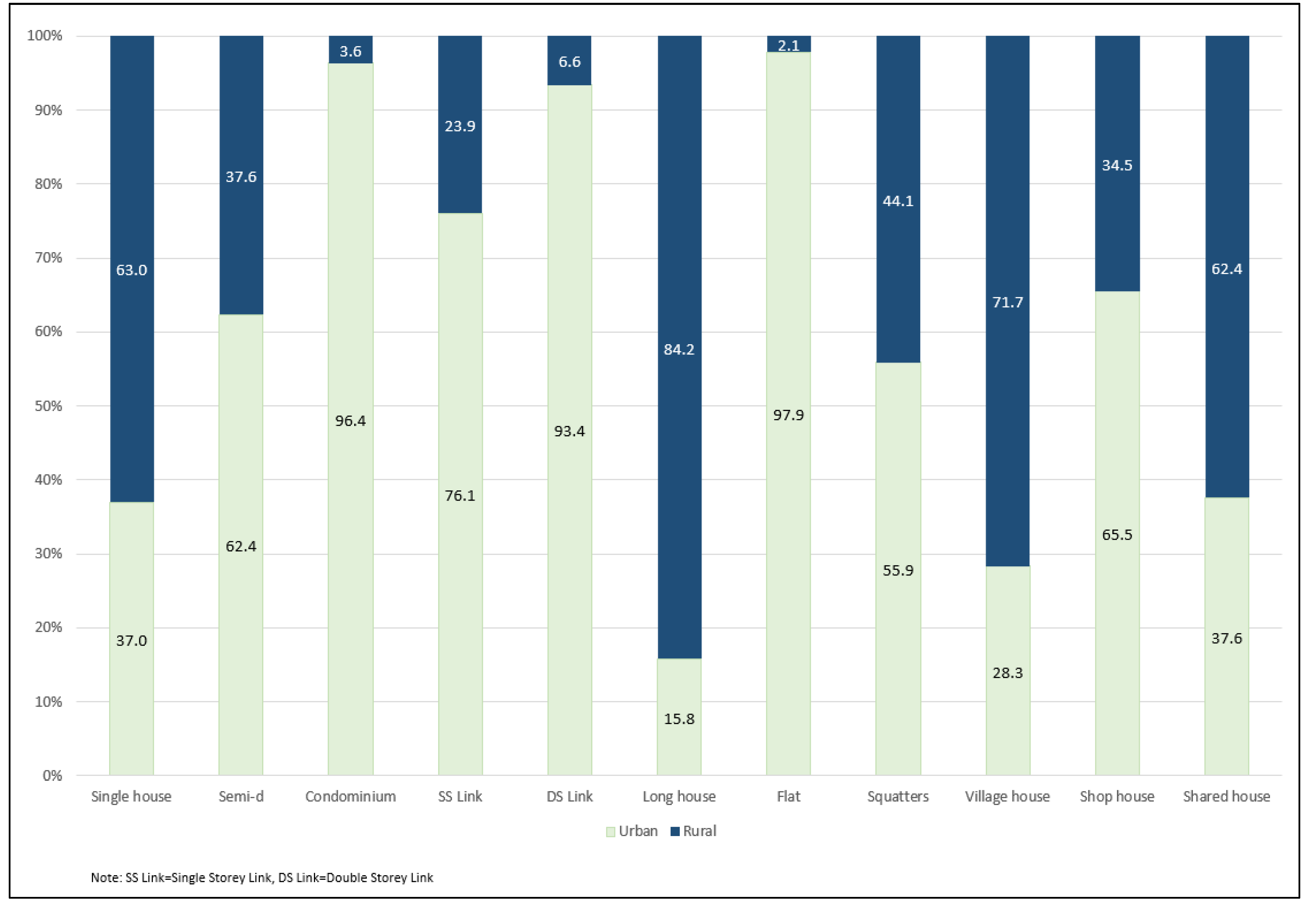

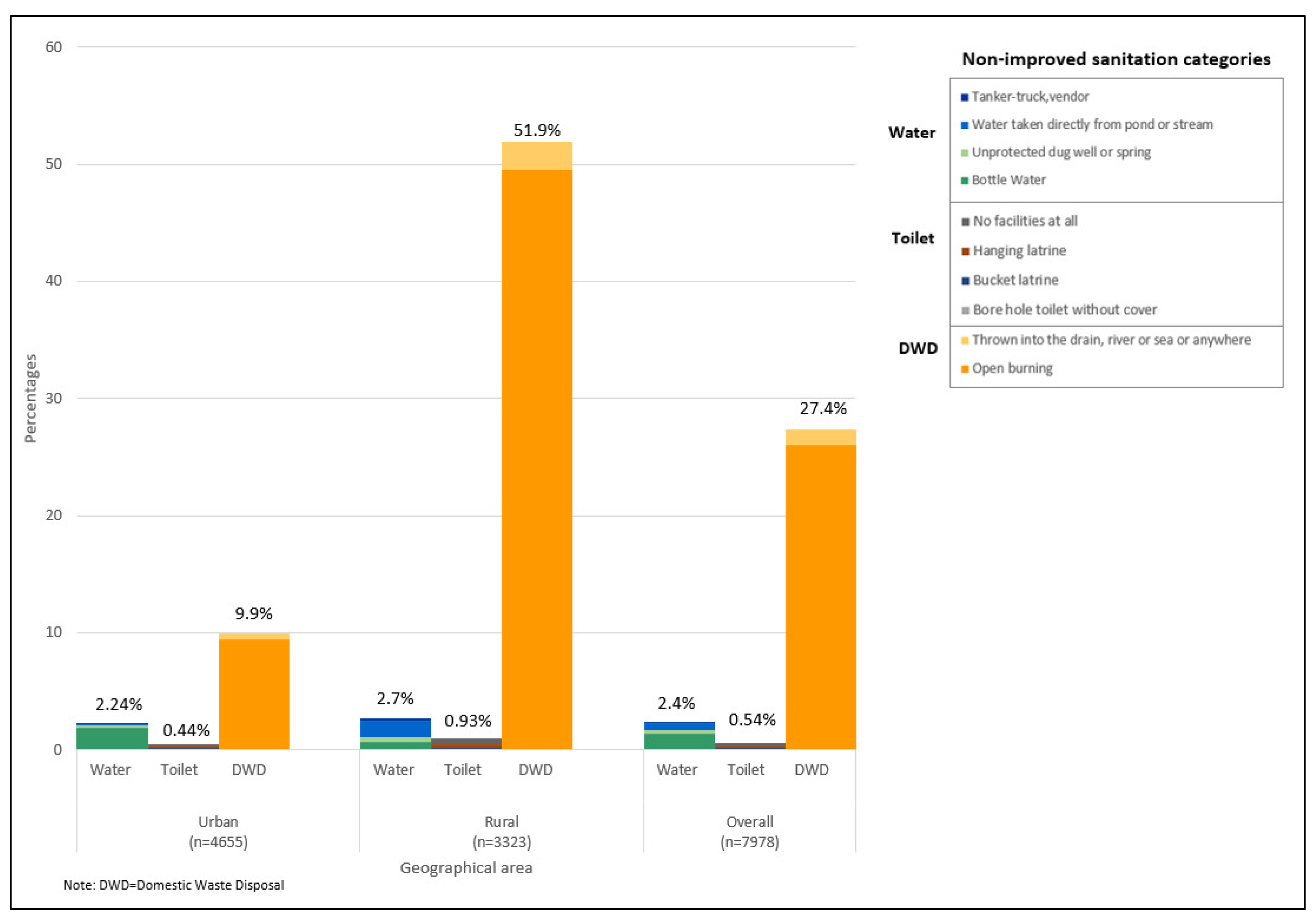
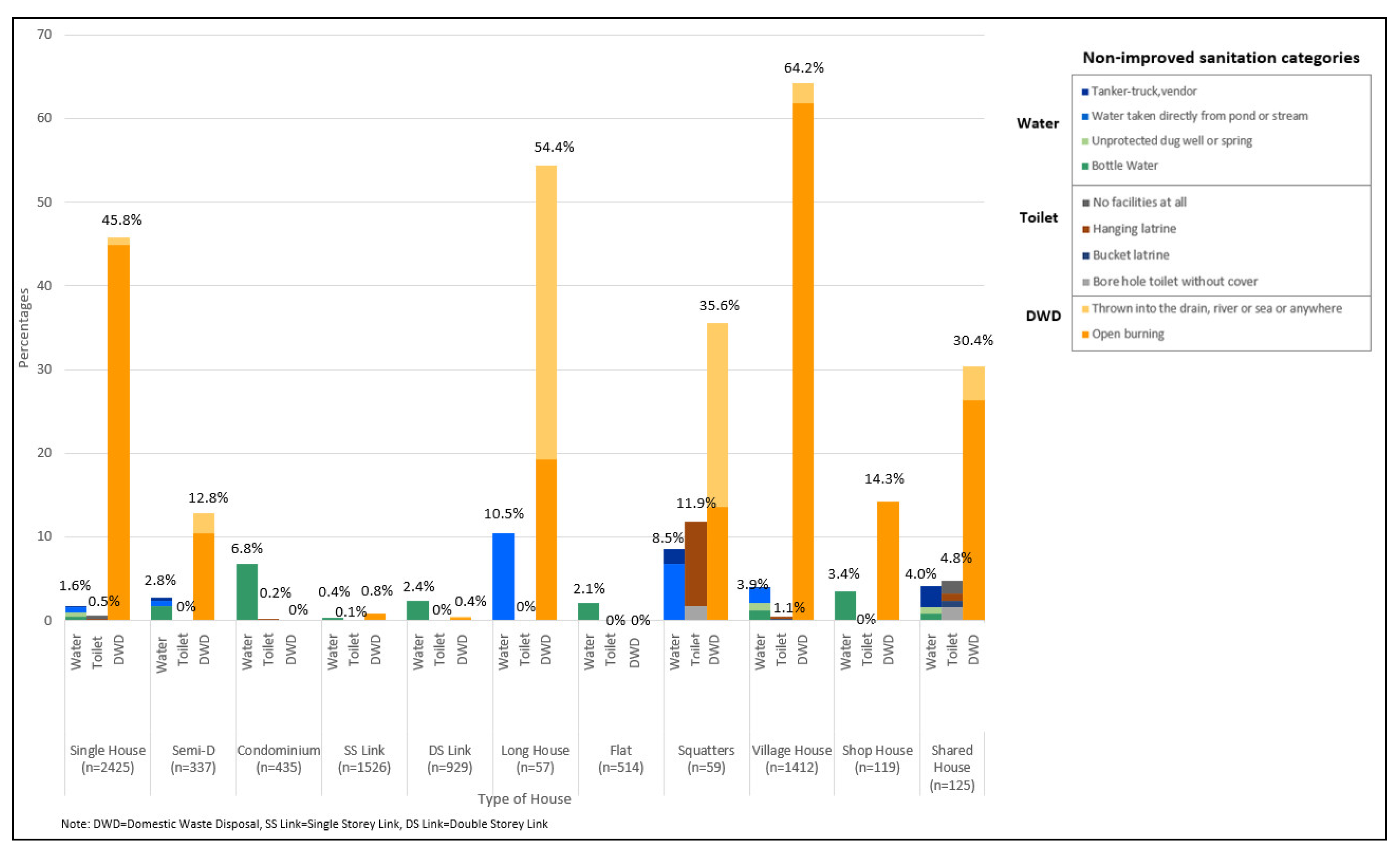
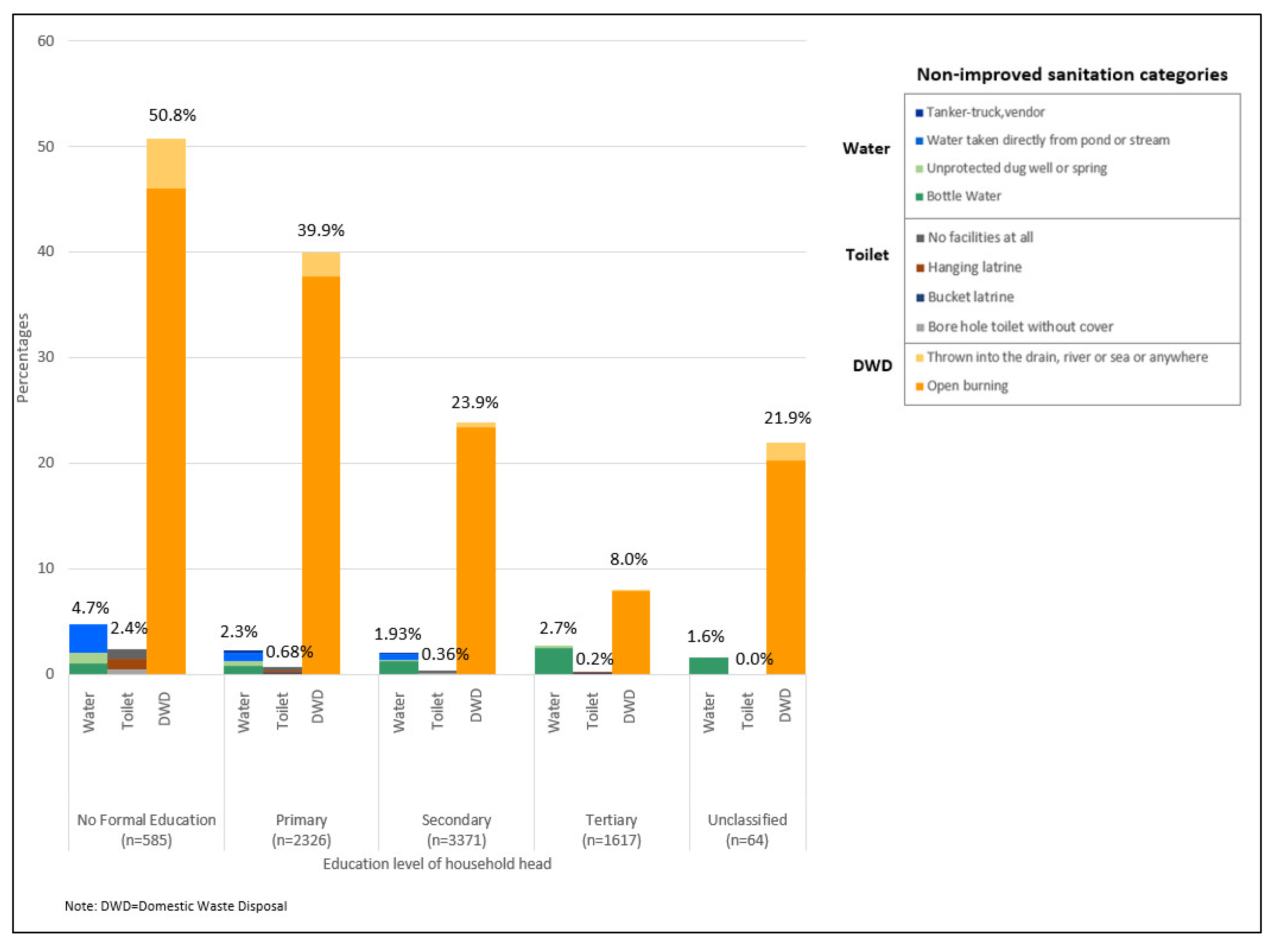
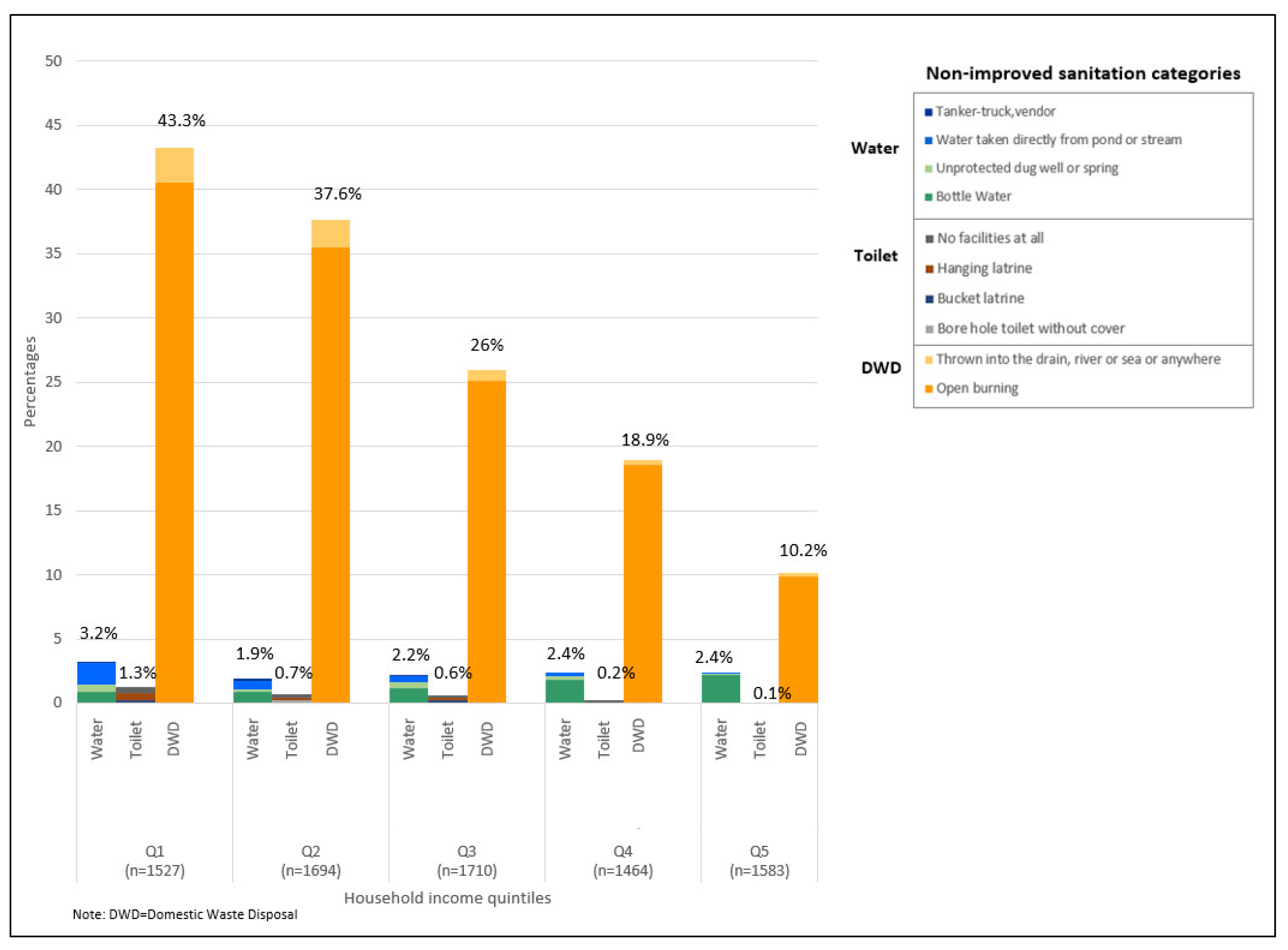
| Variables | Non-Improved Water | Non-Improved Toilet | Improper Domestic Waste Disposal | |||
|---|---|---|---|---|---|---|
| OR a (95% CI: LL, UL) b | p-Value | OR a (95% CI: LL, UL) b | p-Value | OR a (95% CI: LL, UL) b | p-Value | |
| Education level | ||||||
| No formal | 1.38 (0.79, 2.41) | 0.22 | 2.97 (0.61, 14.41) | 0.10 | 2.88 (2.12, 3.91) | 0.00 |
| Primary | 0.69 (0.44, 1.09) | 0.13 | 1.03 (0.22, 4.82) | 0.76 | 1.98 (1.55, 2.53) | 0.00 |
| Secondary | 0.65 (0.44, 0.98) | 0.05 | 0.92 (0.2, 4.36) | 0.87 | 1.7 (1.34, 2.16) | 0.00 |
| Tertiary(ref) c | ||||||
| Household income quintiles | ||||||
| Q1 | 1.08 (0.7, 1.65) | 0.67 | 6.00 (1.65, 21.75) | 0.01 | 2.03 (1.68, 2.46) | 0.00 |
| Q2 | 0.78 (0.5, 1.21) | 0.25 | 3.2 (0.85, 12.03) | 0.10 | 1.78 (1.49, 2.13) | 0.00 |
| Q3 | 0.88 (0.58, 1.33) | 0.52 | 3.88 (1.04, 14.5) | 0.05 | 1.33 (1.11, 1.6) | 0.00 |
| Q4/Q5 (ref) c | ||||||
| Geographical location | ||||||
| Urban (ref) c | ||||||
| Rural | 1.22 (0.86, 1.72) | 0.32 | 1.16 (0.59, 2.31) | 0.66 | 3.74 (3.26, 4.29) | 0.00 |
| House type | ||||||
| Single house (ref) c | ||||||
| Squatters | 6.38 (2.39, 17.04) | 0.00 | 24.86 (9.15, 67.52) | 0.00 | 0.66 (0.37, 1.2) | 0.26 |
| Village house | 2.35 (1.54, 3.58) | 0.00 | 1.66 (0.79, 3.49) | 0.18 | 1.80 (1.56, 2.09) | 0.00 |
| Shop house/Share house | 2.19 (1.01, 4.77) | 0.02 | 4.67 (1.72, 12.66) | 0.00 | 0.35 (0.25, 0.49) | 0.00 |
| Others | 1.45 (0.95, 2.22) | 0.09 | 0.07 (0.01, 0.58) | 0.01 | 0.05 (0.04, 0.07) | 0.00 |
Publisher’s Note: MDPI stays neutral with regard to jurisdictional claims in published maps and institutional affiliations. |
© 2020 by the authors. Licensee MDPI, Basel, Switzerland. This article is an open access article distributed under the terms and conditions of the Creative Commons Attribution (CC BY) license (http://creativecommons.org/licenses/by/4.0/).
Share and Cite
Kong, Y.-L.; Anis-Syakira, J.; Fun, W.H.; Balqis-Ali, N.Z.; Shakirah, M.S.; Sararaks, S. Socio-Economic Factors Related to Drinking Water Source and Sanitation in Malaysia. Int. J. Environ. Res. Public Health 2020, 17, 7933. https://doi.org/10.3390/ijerph17217933
Kong Y-L, Anis-Syakira J, Fun WH, Balqis-Ali NZ, Shakirah MS, Sararaks S. Socio-Economic Factors Related to Drinking Water Source and Sanitation in Malaysia. International Journal of Environmental Research and Public Health. 2020; 17(21):7933. https://doi.org/10.3390/ijerph17217933
Chicago/Turabian StyleKong, Yuke-Lin, Jailani Anis-Syakira, Weng Hong Fun, Nur Zahirah Balqis-Ali, M. S. Shakirah, and Sondi Sararaks. 2020. "Socio-Economic Factors Related to Drinking Water Source and Sanitation in Malaysia" International Journal of Environmental Research and Public Health 17, no. 21: 7933. https://doi.org/10.3390/ijerph17217933
APA StyleKong, Y.-L., Anis-Syakira, J., Fun, W. H., Balqis-Ali, N. Z., Shakirah, M. S., & Sararaks, S. (2020). Socio-Economic Factors Related to Drinking Water Source and Sanitation in Malaysia. International Journal of Environmental Research and Public Health, 17(21), 7933. https://doi.org/10.3390/ijerph17217933






